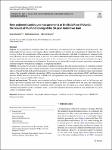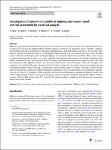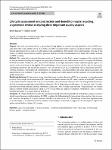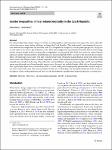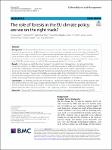Search
Author
- Osman, Ahmed I. (5)
- Chen, Zhonghao (2)
- Ricohermoso III, Emmanuel (2)
- Wang, Yongbin (2)
- next >
Subject
- LCA (6)
- ICP-MS (3)
- Artificial intelligence (2)
- CDW (2)
- next >
Date issued
Has File(s)
- true (220)
Search Results
As documented by multiple studies, the construction of artificial reservoirs influences fluvial processes. The hydrographic barrier causes a water regime change, and the effects are evident in the accumulation of sediment in the reservoir as well as the intensification of the erosion process below the dam due to the lack of sediments for transport in the river. Moreover, the use of lateral canals on the reservoirs causes additional transformations of the river system, excluding the river part below the dam from the natural system of the catchment area. This research aimed to determine the impact of the creation and functioning of the Koronowo Reservoir dam on the Brda River and its lateral canal on the continuum of sediment transport, with particular emphasis on suspended sediment.<... |
In northern Sweden, improvements of grazing conditions are necessary for the continuation of traditional, natural pasture-based reindeer husbandry. Ground and tree lichen constitute the main fodder resource for reindeer during winter but have reached critically low levels. Using a forest decision support system, we prescribe adapted forest management to improve the preconditions for reindeer husbandry and compare outcomes with the continuation of current forest management. We found that adapted management increases the forest area with ground lichen habitat by 22% already within 15 years, while a continuation of current management would result in a further decrease in ground lichen. Tree lichen habitat can be retained and increased in all scenarios, which is important in a changing ... |
Soil carbon sequestration programmes are a way of offsetting GHG emissions, however, it requires agricultural landholders to be engaged in such initiatives for carbon offsets to occur. Farmer engagement is low in market-based programmes for soil carbon credits in Australia. We interviewed long-term practitioners (n = 25) of rotational grazing in high-rainfall lands of New South Wales, Australia to understand their current social-ecological system (SES) of soil carbon management (SCM). The aim was to identify those components of the SES that motivate them to manage soil carbon and also influence their potential engagement in soil carbon sequestration programmes. |
The apparel industry and above all the business model on which it relies (fast fashion) are recognized as the source of marked environmental impacts. An alternative business model such as one of those promoted by the circular economy could be the solution to improve resource productivity and value creation, without damaging the environment. The rental model, or more in general the product-as-a-service, is often linked to multiple benefits such as reduction in environmental impact, increase in competitiveness and user value. However, to be sure of the environmental sustainability of this model, it is necessary to conduct an objective assessment of its application to the context of the apparel industry. |
The bio- and thermal degradation as well as the water absorption properties of a novel biocomposite comprising cellulose nanoparticles, natural rubber and polylactic acid have been investigated. The biodegradation process was studied through an assembled condition based on the soil collected from the central Malaysian palm oil forests located in the University of Nottingham Malaysia. The effects of the presence of the cellulose nanoparticles and natural rubber on the biodegradation of polylactic acid were investigated. The biodegradation process was studied via thermal gravimetric analysis and scanning electron microscopy. It was understood that the reinforcement of polylactic acid with cellulose nanoparticles and natural rubber increases the thermal stability by ~ 20 °C. |
Highway stormwater runoff pollution has become a severe risk factor for water bodies nowadays. The conventional risk analysis protocols for directly discharging highway runoff are prone to systematic and judgmental errors. Therefore, a numeric and straightforward risk assessment protocol has been developed in this study that minimizes the errors. For this study, three highway segments were selected in the city of Rawalpindi, Pakistan. Event mean concentrations have been used as baseline numeric values for calculating the risk of discharging highway stormwater directly into the water bodies. |
New technologies, systems, societal organization and policies for energy saving are urgently needed in the context of accelerated climate change, the Ukraine conflict and the past coronavirus disease 2019 pandemic. For instance, concerns about market and policy responses that could lead to new lock-ins, such as investing in liquefied natural gas infrastructure and using all available fossil fuels to compensate for Russian gas supply cuts, may hinder decarbonization efforts. Here we review energy-saving solutions with a focus on the actual energy crisis, green alternatives to fossil fuel heating, energy saving in buildings and transportation, artificial intelligence for sustainable energy, and implications for the environment and society. |
Life cycle assessment (LCA) is increasingly being applied to construction and demolition waste (CDW) recycling. But what is the current state of LCA studies on CDW recycling? In the context of circular economy, several aspects become important in LCA, such as avoided impacts and consideration of the quality of recycled materials. The aim of this study is to identify inconsistencies and best practices, and then provide recommendations for future LCA studies focusing on CDW recycling. |
It is acknowledged that climate change exacerbates social inequalities, and women have been reported as more vulnerable to heat than men in many studies in Europe, including the Czech Republic. This study aimed at investigating the associations between daily temperature and mortality in the Czech Republic in the light of a sex and gender perspective, taking into account other factors such as age and marital status. Daily mean temperature and individual mortality data recorded during the five warmest months of the year (from May to September) over the period 1995–2019 were used to fit a quasi-Poisson regression model, which included a distributed lag non-linear model (DLNM) to account for the delayed and non-linear effects of temperature on mortality. |
The European Union (EU) has committed to achieve climate neutrality by 2050. This requires a rapid reduction of greenhouse gas (GHG) emissions and ensuring that any remaining emissions are balanced through CO2 removals. Forests play a crucial role in this plan: they are currently the main option for removing CO2 from the atmosphere and additionally, wood use can store carbon durably and help reduce fossil emissions. To stop and reverse the decline of the forest carbon sink, the EU has recently revised the regulation on land use, land-use change and forestry (LULUCF), and set a target of − 310 Mt CO2e net removals for the LULUCF sector in 2030. |

